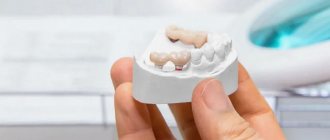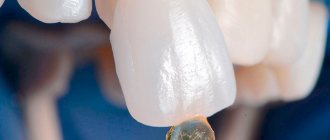How much does a metal-ceramic crown cost in Ukraine?
Many patients are interested in how much it costs to install a prosthesis; It is clear that the cost of a metal-ceramic crown (one piece) and prosthetic services depends on the complexity of installation in each individual case, and the average price of a dental crown (prosthesis) made of metal-ceramics for 1 (one) tooth in “Dentistry from A to Z” (Kyiv, ...
Interesting materials:
Where is the deeper metro in St. Petersburg or Kyiv? Where do black-headed gulls nest? Where do herring gulls nest? Where is horizontal and vertical? Where is the most delicious coffee in the world made? Where and from what is sugar obtained? Where and how was the papyrus stored? Where and how did Nekrasov spend his childhood? Where and how was the film Eternal Call filmed? Where and how did Astafiev study?
Gold crowns - gold dental prosthetics
31.12.2018
Thanks to the achievements of modern dentistry, metal-free dentures are the most popular. But time-tested gold is not going to give up its positions.
Strength, ductility, durability are just some of the advantages of dental structures.
How to put gold crowns on your teeth, what grade of metal to use, features of installation and care - this and much more is discussed later in the article.
When can gold crowns be placed?
What types of gold crowns are there?
What does a gold crown look like? Externally, the structure is no different from your own tooth, but has a characteristic yellow color and a recess inside with which it is attached to the base. Depending on how the products are made, they come in two types:
- stamped - made from ready-made plates or sleeves of standard size. Refinement and adjustment are carried out after fittings. This type of prosthesis fades into the background, since after installation there are often gaps left,
- cast – completely copy the patient’s own tooth. They do not cause chafing of the gums and have a tight fit. They are made individually based on an impression.
The golden frame of the structure can be coated with metal ceramics. In this case, the prosthesis has a natural shade and does not differ from your own. This option, by the way, is more preferable, because the aesthetics are an order of magnitude higher.
What kind of gold is used to make prosthetics?
What standard of gold is used for dental crowns, and what are they made of? In dentistry, pure metal is rarely used - as a rule, the alloy also contains silver and copper. There are alloys with the addition of platinum or palladium. The fineness depends on the percentage of gold component in the product, which also determines its scope of application.
Gold purity (%)Where it is usedFeatures
| 916 | 91,6 | Used for the manufacture of inlays, single dentures, bridges | Has high corrosion resistance and hardness, easy to process |
| 900 | 90,0 | Same as in the previous version | Same as 916, but with greater hardness |
| 750 | 75,0 | In the manufacture of individual parts of removable dentures (clasps, hooks). Also suitable as solder for high grade elements | Has a low melting point |
| 583 | 58,3 | It is the basis for pins and other individual parts | Characterized by low corrosion resistance |
You can often hear the question: how much does a gold crown weigh on a tooth? The weight of the product is determined by its size, wall thickness, and degree of wear. On average, the weight of the structure ranges from 0.3-2 g. The product, which consists of several gold teeth in a row, can weigh up to 9-10 grams.
Indications for installation
Gold dental prosthetics
Indications for the installation of a gold crown are the following clinical situations:
- the need to restore the anatomical form and functions of the dentition units,
- strong bite
- restoration of chewing teeth,
- the aesthetics of the dentition is impaired,
- there is a habit of clenching teeth, grinding at night,
- allergic reactions to other materials.
Gold structures are most often the choice if the patient is intolerant to other materials used for prosthetics. In particular, classical metals - they often contain nickel, which is the highest allergen.
In what cases should such products not be installed?
There are also contraindications for use:
- the patient has not reached 16 years of age,
- period of bearing a child,
- the presence of mental disorders.
If there is an inflammatory process in the periodontal tissues, the installation of the prosthesis is postponed until complete healing.
How is production and installation carried out?
For installation, you must contact a dental institution.
To work with precious metal, any clinic must have a license, obtaining which involves some difficulties and requires appropriate training and experience as a specialist.
Therefore, there are only a few such clinics, and in most cases in private dentistry it is possible to install products containing gold only as one of the components of the alloy.
“I inserted gold teeth a long time ago. Gradually they wore off, and I began to look for where to put new gold crowns. It turned out that this is such a problem!!! They offer something, but as soon as it comes to the certificate, there is nothing... I was thinking about installing metal ceramics, but at the last moment I found a large clinic. The price, of course, is off the charts, but everything seems to be in order with the documents.”
Antonina, 65 years old
Crown installation has several stages
The manufacture and installation of gold dentures generally proceeds as follows:
- preparatory stage - consists of removing plaque on the tooth, treating caries, refilling and other measures,
- grinding your own tooth - giving it a cone shape, sawing out ledges in the neck area for a tight fit and compliance with the crown,
- taking impressions, transferring them to a dental laboratory,
- production of a prosthesis based on the impressions obtained,
- fitting, if necessary - correction (carried out in a laboratory),
- fixing the product with cement.
On a note! It is recommended to cover the prepared tooth with a temporary structure while the crown is being made. This will prevent it from exposure to external factors, reduce the likelihood of destruction, and reduce discomfort. If it breaks, then the prosthesis, which is being created in the laboratory at this time, simply will not fit.
Features of the recovery period
Sometimes sensitivity occurs during the rehabilitation period
After having gold teeth installed, the patient may encounter some problems:
- pain: most often they speak of incorrect placement of the structure. To fix it, you need to contact your dentist - if the crown “fits” poorly, then it may have to be redone. But if pain occurs months after prosthetics, then most likely an inflammatory process has begun to develop under the prosthesis - you need to take an x-ray and evaluate the condition of the dental tissues,
- the tooth becomes sensitive to external influences: it occurs if the nerve was preserved during preparation for prosthetics. To reduce sensitivity, you can use special care products (paste and rinse for sensitive teeth). But in general, it is better not to allow the pulp to remain under the crown, because nerve inflammation is a matter of time,
- weakening of fixation: may occur when the cement base is washed out. To prevent the development of infection under the material, you should consult a doctor as soon as possible,
- falling out of the structure: observed due to improper installation, poor fit, and washout of cement. Contacting a specialist will help resolve the problem.
Whether you can eat food immediately after installation depends on what cement mixture the doctor used to fix the prosthesis. If you need to wait a certain time, the specialist will warn you about this. It is recommended to exclude solid foods from the diet for several days to allow the tissues to adapt and prevent accidental biting of the tongue or cheek.
Benefits of gold dentures
Among the advantages of gold teeth are the following:
- gold has excellent biological compatibility with living tissues,
- the metal does not oxidize and does not affect the taste of food,
- gold ions, entering the digestive tract, help prevent inflammatory processes,
- as a rule, this material does not cause allergic reactions, especially if it does not contain foreign impurities,
- the ability of metal to contract and expand is similar to that of natural dental tissue, so the likelihood of cracks is minimized,
- such dentures are highly durable and resistant to chewing loads,
- the plasticity of the metal makes it possible to achieve a tight fit of the structure,
- over time, the material does not stain or darken,
- gold combines well with many other metals and materials; it can be used in different designs and individual elements.
Gold has excellent biocompatibility with living teeth
With high-quality hygienic care, products can last 20 years or more.
Disadvantages of gold designs
Gold teeth also have disadvantages. Firstly, as in the case of other materials, your own tooth undergoes serious processing, loses its enamel layer and a certain amount of hard tissue.
Secondly, the yellow color of the material does not allow the structure to be installed on the front row units due to aesthetic reasons. Therefore, gold crowns are most often installed on the chewing group.
And finally, due to the high cost, not every patient can afford a gold structure.
Product care
Caring for dental structures is not fundamentally different from caring for your own teeth. To clean them from plaque without scratching the surface, it is not recommended to use highly abrasive pastes. You should not use threads either, as the risk of violating the tightness of the product increases. An alternative in this case may be to use an irrigator.
After eating, you should rinse your teeth with plain water. In addition, experts advise periodically carrying out ultrasonic cleaning. The procedure does not harm the structure and helps restore the shine and smoothness of the surface. At the same time, the living tissues of the teeth are cared for.
How to clean a gold structure
If the structure falls out or is replaced with another material, the product can be returned to a collection point. However, before this, it must be cleaned of cement and tooth debris.
If the crown falls out, it can be cleaned and returned
How to clean a gold crown? Different methods are used for this:
- in stores selling dental products and equipment, you can purchase a special preparation that dissolves the remains of the cement mixture,
- plastic elements can be removed from the surface of the structure by heating over a burning burner,
- if there is a lot of cement, then it can be removed by gently tapping the product with a heavy object,
- a heated mixture of hydrogen peroxide, ammonia and liquid soap will help remove particles of the fixing composition. To do this, the product should be kept in the solution for a while and cleaned with a brush. After treatment, the prosthesis should be thoroughly rinsed with running water and wiped dry.
In general, the best way to clean a gold crown is to use the services of a professional. In the dental laboratory, the product is treated with fire and hydrochloric acid. As a result, gold restores its color, shine, and is cleared of foreign particles.
Removing crowns: nuances
How to remove a gold crown from a tooth or dentures without unpleasant consequences? To do this, you need to contact your dentist.
Correct removal of the structure can only be done with special tools and by sawing. The mechanism of action of the devices is based on air pressure (pneumatic) or mechanical destruction of cement (spring).
In addition, the product can be removed using a special ultrasonic device.
Before removing the crown, an X-ray of the tooth is required. If its condition is poor and there are indications for removal, the doctor can remove the structure along with the remains of the dental unit.
How much does it cost to install a gold crown?
How much a gold crown costs per tooth depends on several nuances: the sample, the presence of other metals in the alloy, the manufacturing method, the weight of the structure, the status of the clinic, and others. The price for one unit can average from 20,000 to 40,000 rubles.











